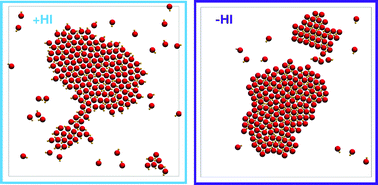Clustering of self-thermophilic asymmetric dimers: the relevance of hydrodynamics†
Abstract
Self-thermophilic dimers are characterized by a net phoretic attraction which, in combination with hydrodynamic interactions, results in the formation of crystalline-like aggregates. To distinguish the effect of the different contributions is frequently an important challenge. We present a simulation investigation done in parallel in the presence and the absence of hydrodynamic interactions for the case of asymmetric self-thermophoretic dimers. In the absence of hydrodynamics, the clusters have the standard heads-in configurations. In contrast, in the presence of hydrodynamics, clusters with heads-in conformation are being formed, in which dimers with their propulsion velocity pointing out of the cluster are assembled and stabilized by strong hydrodynamic osmotic flows. Significant variation in the material properties is to be expected from such differences in the collective behavior, whose understanding and control is of great relevance for the development of new synthetic active materials.



 Please wait while we load your content...
Please wait while we load your content...